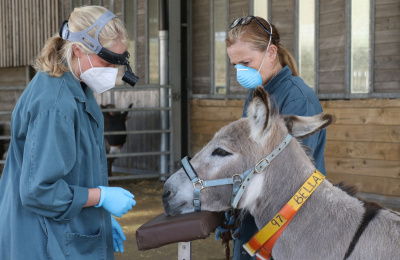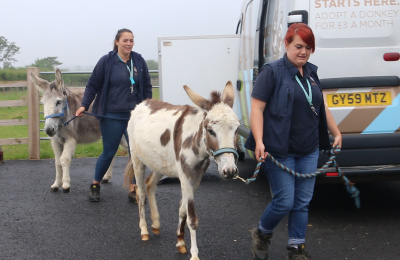Casey was born with ballerina syndrome and could only walk on the tips of his toes. Learn about the programme of stretching, physiotherapy and remedial farrier work that has helped to transform his life.
Casey the two-year-old donkey is a firm favourite within his herd at our Brookfield Farm near Honiton, Devon. Since his birth in July 2018, he has struggled with a medical condition called ballerina syndrome. Donkeys with this condition are unable to fully bear weight across their foot and stand on their toes instead.
Without treatment, Casey would have been unbalanced and susceptible to falling over throughout his life, but thanks to our wonderful supporters and the persistence and expertise of our veterinary team, Casey is now able to trot around with ease and play with his buddies.
First steps
Casey’s groom, Maria Hughes, says: “It does not bear thinking about what would have happened to Casey had we not been able to step in and provide him with all the care and treatment he needed. Our supporters’ generosity meant that we could treat him immediately.”
Treatment began just two months after he was welcomed to the world. Maria says: “Three times a day, we would stretch each of Casey’s front legs. We held one hoof and stretched down the back of the leg, which helped to slowly lengthen the tendon. We hoped this would encourage him to put his foot down and heel back properly.
“At the same time, farrier Matt Sherring fitted extensions onto Casey’s front toes to bring his heel down on the ground.”
Walking up and down a slope every day alongside our staff helped to exercise the tendons and encourage his body to adapt to a more natural position.
Although the results were not immediate, we refused to be disheartened in our quest to have Casey walking properly. We began to see minor progression week by week, and by January 2019, Casey’s legs had markedly improved.
Maria says: “We were elated to see Casey’s condition improving. However, with all physiotherapy cases, there are ups and down and Casey’s situation was no different.
A lengthy process
“Three months after thinking Casey was on the road to walking properly, we hit a setback. In April, he began to walk on tiptoes again, a sign that his ballerina syndrome was fighting back against the daily routine we had to set out for him.”
Casey would receive constant attention from our farriers throughout the summer and winter months of 2019.
Maria adds: “We knew that this would be a long process. Think of donkeys’ hooves growing as slowly as human nails; we had to bide our time and trust that what we were doing was best for Casey’s development.
“Throughout the 12 months, Casey had his feet seen to every four weeks. Everybody was instrumental to our commitment that his legs would be repaired, however long the programme would take.”
The final hurdle in Casey’s development presented itself in March 2020. Despite all of our remedial work, we were concerned that the signs of the ballerina syndrome were creeping back.
Maria says: “We could see Casey starting to come back onto his tiptoes. When he walked it was very obvious. We showed the vet and farrier, and they recommended that we fit him with special shoes to help him walk properly. The results have been beyond fantastic – we could not believe how amazing his feet now look.”
A life of comfort
Looking back at Casey’s journey, Maria knows that effort was well worth it.
She says: “This has been a team effort from day one. So many people have contributed to Casey’s amazing recovery, ensuring he enjoys the rest of his life in comfort. His recovery took more than two years, and now he live his best life with his friends at Brookfield.”




